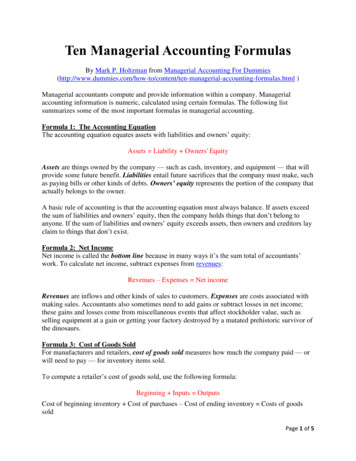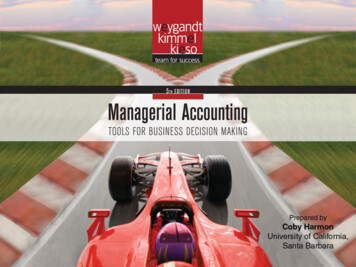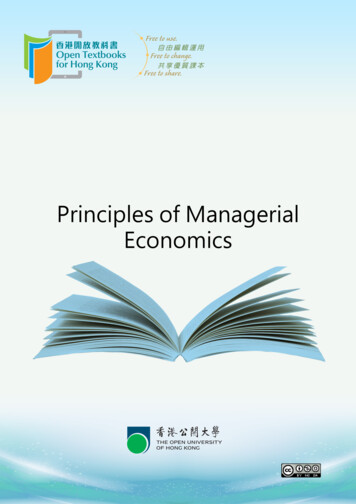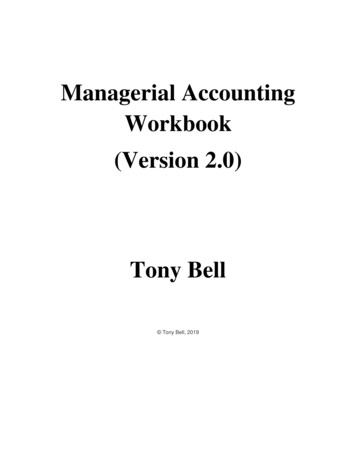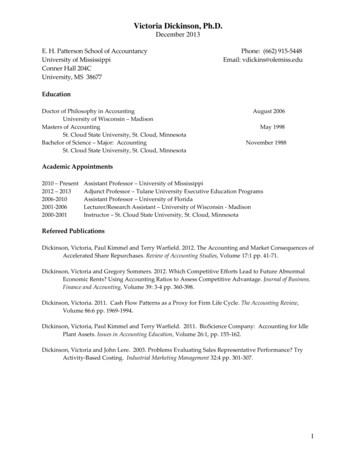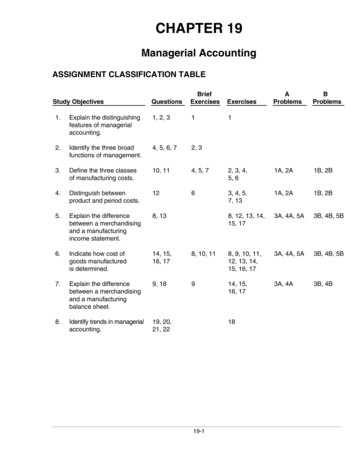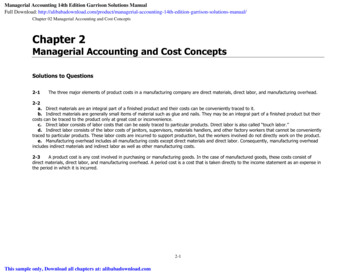
Transcription
Managerial Accounting 14th Edition Garrison Solutions ManualFull Download: ter 02 Managerial Accounting and Cost ConceptsChapter 2Managerial Accounting and Cost ConceptsSolutions to Questions2-1The three major elements of product costs in a manufacturing company are direct materials, direct labor, and manufacturing overhead.2-2a. Direct materials are an integral part of a finished product and their costs can be conveniently traced to it.b. Indirect materials are generally small items of material such as glue and nails. They may be an integral part of a finished product but theircosts can be traced to the product only at great cost or inconvenience.c. Direct labor consists of labor costs that can be easily traced to particular products. Direct labor is also called “touch labor.”d. Indirect labor consists of the labor costs of janitors, supervisors, materials handlers, and other factory workers that cannot be convenientlytraced to particular products. These labor costs are incurred to support production, but the workers involved do not directly work on the product.e. Manufacturing overhead includes all manufacturing costs except direct materials and direct labor. Consequently, manufacturing overheadincludes indirect materials and indirect labor as well as other manufacturing costs.2-3A product cost is any cost involved in purchasing or manufacturing goods. In the case of manufactured goods, these costs consist ofdirect materials, direct labor, and manufacturing overhead. A period cost is a cost that is taken directly to the income statement as an expense inthe period in which it is incurred.2-1This sample only, Download all chapters at: alibabadownload.com
Chapter 02 Managerial Accounting and Cost Concepts2-4a. Variable cost: The variable cost per unit is constant, but total variable cost changes in direct proportion to changes in volume.b. Fixed cost: The total fixed cost is constant within the relevant range. The average fixed cost per unit varies inversely with changes in volume.c. Mixed cost: A mixed cost contains both variable and fixed cost elements.2-5a. Unit fixed costs decrease as volume increases.b. Unit variable costs remain constant as volume increases.c. Total fixed costs remain constant as volume increases.d. Total variable costs increase as volume increases.2-6a. Cost behavior: Cost behavior refers to the way in which costs change in response to changes in a measure of activity such as sales volume,production volume, or orders processed.b. Relevant range: The relevant range is the range of activity within which assumptions about variable and fixed cost behavior are valid.2-7An activity base is a measure of whatever causes the incurrence of a variable cost. Examples of activity bases include units produced,units sold, letters typed, beds in a hospital, meals served in a cafe, service calls made, etc.2-2
Chapter 02 Managerial Accounting and Cost Concepts2-8The linear assumption is reasonably valid providing that the cost formula is used only within the relevant range.2-9A discretionary fixed cost has a fairly short planning horizon—usually a year. Such costs arise from annual decisions by management tospend on certain fixed cost items, such as advertising, research, and management development. A committed fixed cost has a long planninghorizon—generally many years. Such costs relate to a company’s investment in facilities, equipment, and basic organization. Once such costs havebeen incurred, they are “locked in” for many years.2-10 Yes. As the anticipated level of activity changes, the level of fixed costs needed to support operations may also change. Most fixed costsare adjusted upward and downward in large steps, rather than being absolutely fixed at one level for all ranges of activity.2-11 The high-low method uses only two points to determine a cost formula. These two points are likely to be less than typical because theyrepresent extremes of activity.2-12 The formula for a mixed cost is Y a bX. In cost analysis, the “a” term represents the fixed cost and the “b” term represents thevariable cost per unit of activity.2-13 The term “least-squares regression” means that the sum of the squares of the deviations from the plotted points on a graph to theregression line is smaller than could be obtained from any other line that could be fitted to the data.2-14 The contribution approach income statement organizes costs by behavior, first deducting variable expenses to obtain contribution margin,and then deducting fixed expenses to obtain net operating income. The traditional approach organizes costs by function, such as production,selling, and administration. Within a functional area, fixed and variable costs are intermingled.2-15The contribution margin is total sales revenue less total variable expenses.2-16 A differential cost is a cost that differs between alternatives in a decision. An opportunity cost is the potential benefit that is given upwhen one alternative is selected over another. A sunk cost is a cost that has already been incurred and cannot be altered by any decision takennow or in the future.2-17 No, differential costs can be either variable or fixed. For example, the alternatives might consist of purchasing one machine rather thananother to make a product. The difference between the fixed costs of purchasing the two machines is a differential cost.2-3
Chapter 02 Managerial Accounting and Cost ConceptsExercise 2-1 (10 minutes)1. The wages of employees who build the sailboats: direct labor cost.2. The cost of advertising in the local newspapers: marketing and selling cost.3. The cost of an aluminum mast installed in a sailboat: direct materials cost.4. The wages of the assembly shop’s supervisor: manufacturing overhead cost.5. Rent on the boathouse: a combination of manufacturing overhead, administrative, and marketing andselling cost. The rent would most likely be prorated on the basis of the amount of space occupied bymanufacturing, administrative, and marketing operations.6. The wages of the company’s bookkeeper: administrative cost.7. Sales commissions paid to the company’s salespeople: marketing and selling cost.8. Depreciation on power tools: manufacturing overhead cost.2-4
Chapter 02 Managerial Accounting and Cost ConceptsExercise 2-2 (15 minutes)1. The cost of the memory chips used in aradar set .2. Factory heating costs .3. Factory equipment maintenance costs .4. Training costs for new administrativeemployees .5. The cost of the solder that is used inassembling the radar sets .6. The travel costs of the company’ssalespersons .7. Wages and salaries of factory securitypersonnel .8. The cost of air-conditioningexecutive offices .9. Wages and salaries in the department thathandles billing customers .10. Depreciation on the equipment in thefitness room used by factory workers.11. Telephone expenses incurred by factorymanagement .12. The costs of shipping completed radar setsto customers .13. The wages of the workers who assemblethe radar sets .ProductCostPeriodCostXXXXXXXXXXXXX2-5
Chapter 02 Managerial Accounting and Cost Concepts14. The president’s salary .15. Health insurance premiums for factorypersonnel .XX2-6
Chapter 02 Managerial Accounting and Cost ConceptsExercise 2-3 (15 minutes)1.Cups of Coffee Servedin a Week1,8001,9002,000Fixed cost . 1,100 1,100 1,100Variable cost .468494520Total cost . 1,568 1,594 1,620Average cost per cup served* . 0.871 0.839 0.810* Total cost cups of coffee served in a week2. The average cost of a cup of coffee declines as the number of cups of coffee served increasesbecause the fixed cost is spread over more cups of coffee.2-7
Chapter 02 Managerial Accounting and Cost ConceptsExercise 2-4 (20 minutes)1.High activity level (August) .Low activity level (October).Change .OccupancyDays3,6081863,422ElectricalCosts 8,1111,712 6,399Variable cost Change in cost Change in activity 6,399 3,422 occupancy-days 1.87 per occupancy-dayTotal cost (August) .Variable cost element( 1.87 per occupancy-day 3,608 occupancy-days)Fixed cost element . 8,1116,747 1,3642. Electrical costs may reflect seasonal factors other than just the variation in occupancy days. Forexample, common areas such as the reception area must be lighted for longer periods during thewinter. This will result in seasonal effects on the fixed electrical costs.Additionally, fixed costs will be affected by how many days are in a month. In other words, costslike the costs of lighting common areas are variable with respect to the number of days in the month,but are fixed with respect to how many rooms are occupied during the month.Other, less systematic, factors may also affect electrical costs such as the frugality of individualguests. Some guests will turn off lights when they leave a room. Others will not.2-8
Chapter 02 Managerial Accounting and Cost ConceptsExercise 2-5 (15 minutes)1. Traditional income statementRedhawk, Inc.Traditional Income StatementSales ( 15 per unit 10,000 units) .Cost of goods sold( 12,000 90,000 – 22,000) .Gross margin.Selling and administrative expenses:Selling expenses(( 2 per unit 10,000 units) 20,000) .Administrative expenses(( 1 per unit 10,000 units) 15,000) .Net operating income . 150,00080,00070,00040,00025,00065,000 5,0002. Contribution format income statementRedhawk, Inc.Contribution Format Income StatementSales .Variable expenses:Cost of goods sold( 12,000 90,000 – 22,000) .Selling expenses ( 2 per unit 10,000 units) .Administrative expenses( 1 per unit 10,000 units) . 150,000 80,00020,00010,0002-9110,000
Chapter 02 Managerial Accounting and Cost ConceptsContribution margin .Fixed expenses:Selling expenses .Administrative expenses .Net operating income .40,00020,00015,0002-1035,000 5,000
Chapter 02 Managerial Accounting and Cost ConceptsExercise 2-6 (15 minutes)Cost1. The salary of the headchef2. The salary of the headchef3. Room cleaning supplies4. Flowers for thereception desk5. The wages of thedoorman6. Room cleaning supplies7. Fire insurance on thehotel building8. Towels used in the gymCost ObjectThe hotel’s restaurantDirectCostXIndirectCostA particular restaurantcustomerA particular hotel guestA particular hotel guestXA particular hotel guestXXXThe housecleaningdepartmentThe hotel’s gymXThe hotel’s gymXXNote: The room cleaning supplies would most likely be considered an indirect cost of a particularhotel guest because it would not be practical to keep track of exactly how much of each cleaningsupply was used in the guest’s room.2-11
Chapter 02 Managerial Accounting and Cost ConceptsExercise 2-7 (15 minutes)Item1. Cost of the new flat-paneldisplays.2. Cost of the old computerterminals .3. Rent on the space occupied bythe registration desk .4. Wages of registration deskpersonnel .5. Benefits from a new freezer.6. Costs of maintaining the oldcomputer terminals .7. Cost of removing the oldcomputer terminals .8. Cost of existing registrationdesk XXNote: The costs of the rent on the space occupied by the registration desk and the wages ofregistration desk personnel are neither differential costs, opportunity costs, nor sunk costs. These arecosts that do not differ between the alternatives and are therefore irrelevant in the decision, but theyare not sunk costs since they occur in the future.2-12
Chapter 02 Managerial Accounting and Cost ConceptsExercise 2-8 (20 minutes)1. The company’s variable cost per unit would be: 150,000 2.50 per unit.60,000 unitsIn accordance with the behavior of variable and fixed costs, the completed schedule is:Units produced and soldTotal costs:Variable costs .Fixed costs .Total costs .Cost per unit:Variable cost .Fixed cost .Total cost per unit .60,00080,000100,000 150,000360,000 510,000 200,000360,000 560,000 250,000360,000 610,000 2.506.00 8.50 2.504.50 7.00 2.503.60 6.102. The company’s income statement in the contribution format is:Sales (90,000 units 7.50 per unit) .Variable expenses (90,000 units 2.50 per unit) .Contribution margin.Fixed expenses .Net operating income .2-13 675,000225,000450,000360,000 90,000
Chapter 02 Managerial Accounting and Cost ConceptsExercise 2-9 (30 minutes)Name of the CostRental revenue forgone, 40,000per year .Direct materials cost, 40 per unit .Supervisor’s salary, 2,500 permonth .Direct labor cost, 18 per unit .Rental cost of warehouse, 1,000per month .Rental cost of equipment, 3,000per month .Depreciation of the building, 10,000 per year .Advertising cost, 50,000 peryear .Shipping cost, 10 per unit .Electrical costs, 2 per unit .Return earned on investments, 6,000 per year .VariableCostFixedCostProduct CostPeriodDirectDirectMfg.(Selling and Opportunity SunkMaterials Labor Overhead Admin.) CostCostCostXXXXXXXXXXXXXXXXXXXXX2-14
Chapter 02 Managerial Accounting and Cost ConceptsExercise 2-10 (45 minutes)1. The scattergraph appears below:2-15
Chapter 02 Managerial Accounting and Cost ConceptsYes, there is an approximately linear relationship between the number of units shipped and the totalshipping expense.2-16
Chapter 02 Managerial Accounting and Cost ConceptsExercise 2-10 (continued)2.High activity level .Low activity level .Change .Units Shipped826Shipping Expense 3,6001,500 2,100Variable cost element:Change in cost 2,100 350 per unitChange in activity 6 unitsFixed cost element:Shipping expense at the high activity level .Less variable cost element ( 350 per unit 8 units).Total fixed cost . 3,6002,800 800The cost formula is 800 per month plus 350 per unit shipped, or:Y 800 350X,where X is the number of units shipped.The scattergraph on the following page shows the straight line drawn through the high and low datapoints.Exercise 2-10 (continued)2-17
Chapter 02 Managerial Accounting and Cost Concepts3. The high-low estimate of fixed costs is 210.71 lower than the estimate provided by least-squaresregression. The high-low estimate of the variable cost per unit is 32.14 lower than the estimateprovided by least-squares regression. A straight line that minimized the sum of the squared errors2-18
Chapter 02 Managerial Accounting and Cost Conceptswould intersect the Y-axis at 1,010.71 instead of 800. It would also have a flatter slope becausethe estimated variable cost per unit is lower than the high-low method.4. The cost of shipping units is likely to depend on the weight and volume of the units shipped and thedistance traveled as well as on the number2-19
Chapter 02 Managerial Accounting and Cost Conceptsof units shipped. In addition, higher cost shipping might be necessary to meet a deadline.Exercise 2-11 (20 minutes)1. Traditional income statementHaaki Shop, Inc.Traditional Income StatementSales .Cost of goods sold( 80,000 320,000 – 100,000) .Gross margin.Selling and administrative expenses:Selling expenses (( 50 per unit 2,000surfboards*) 150,000) .Administrative expenses (( 20 per unit 2,000units) 120,000) .Net operating income . 800,000300,000500,000250,000160,000410,000 90,000* 800,000 sales 400 per surfboard 2,000 surfboards.2. Contribution format income statementHaaki Shop, Inc.Contribution Format Income StatementSales .Variable expenses:Cost of goods sold( 80,000 320,000 – 100,000) . 800,000 300,0002-20
Chapter 02 Managerial Accounting and Cost ConceptsSelling expenses( 50 per unit 2,000 surfboards) .Administrative expenses( 20 per unit 2,000 surfboards) .Contribution margin .Fixed expenses:Selling expenses .Administrative expenses .Net operating income 000 90,000
Chapter 02 Managerial Accounting and Cost ConceptsExercise 2-11 (continued)2. Since 2,000 surfboards were sold and the contribution margin totaled 360,000 for the quarter, thecontribution of each surfboard toward fixed expenses and profits was 180 ( 360,000 2,000surfboards 180 per surfboard).2-22
Chapter 02 Managerial Accounting and Cost ConceptsExercise 2-12 (20 minutes)1.High level of activity .Low level of activity .Change .MilesDrivenTotalAnnualCost*120,000 13,92080,000 10,88040,000 3,040* 120,000 miles 0.116 per mile 13,92080,000 miles 0.136 per mile 10,880Variable cost per mile:Change in cost 3,040 0.076 per mileChange in activity 40,000 milesFixed cost per year:Total cost at 120,000 miles .Less variable cost element:120,000 miles 0.076 per mile .Fixed cost per year . 13,9209,120 4,8002. Y 4,800 0.076X3. Fixed cost .Variable cost: 100,000 miles 0.076 per mile .Total annual cost .2-23 4,8007,600 12,400
Chapter 02 Managerial Accounting and Cost ConceptsExercise 2-13 (30 minutes)1.High activity level (February).Low activity level (June) .Change .X-rays Taken7,0003,0004,000X-ray Costs 29,00017,000 12,000Variable cost per X-ray:Change in cost 12,000 3.00 per X-rayChange in activity 4,000 X-raysFixed cost per month:X-ray cost at the high activity level .Less variable cost element:7,000 X-rays 3.00 per X-ray .Total fixed cost . 29,00021,000 8,000The cost formula is 8,000 per month plus 3.00 per X-ray taken or:Y 8,000 3.00X2. Expected X-ray costs when 4,600 X-rays are taken:Variable cost: 4,600 X-rays 3.00 per X-ray.Fixed cost .Total cost .Exercise 2-13 (continued)2-24 13,8008,000 21,800
Chapter 02 Managerial Accounting and Cost Concepts3. The scattergraph appears below.2-25
Chapter 02 Managerial Accounting and Cost ConceptsExercise 2-13 (continued)4. The high-low estimate of fixed costs is 1,470.59 higher than the estimate provided by least-squaresregression. The high-low estimate of the variable cost per unit is 0.29 lower than the estimateprovided by least-squares regression. A straight line that minimized the sum of the squared errorswould intersect the Y-axis at 6,529.41 instead of 8,000. It would also have a steeper slope becausethe estimated variable cost per unit is higher than the high-low method.2-26
Chapter 02 Managerial Accounting and Cost Concepts5. Expected X-ray costs when 4,600 X-rays are taken:Variable cost: 4,600 X-rays 3.29 per X-ray.2-27 15,134
Chapter 02 Managerial Accounting and Cost ConceptsFixed cost (rounded).Total cost .2-286,529 21,663
Chapter 02 Managerial Accounting and Cost ConceptsProblem 2-14 (45 minutes)1.House Of Organs, Inc.Traditional Income StatementFor the Month Ended November 30Sales (60 organs 2,500 per organ) .Cost of goods sold(60 organs 1,500 per organ) .Gross margin .Selling and administrative expenses:Selling expenses:Advertising .Delivery of organs(60 organs 60 per organ) .Sales salaries and commissions[ 4,800 (4% 150,000)] .Utilities .Depreciation of sales facilities .Total selling expenses .Administrative expenses:Executive salaries .Depreciation of office equipment.Clerical[ 2,500 (60 organs 40 per organ)] .Insurance .Total administrative expenses .Total selling and administrative expenses .2-29 150,00090,00060,000 041,000
Chapter 02 Managerial Accounting and Cost ConceptsNet operating income .Problem 2-14 (continued)2.House Of Organs, Inc.Contribution Format Income StatementFor the Month Ended November 302-30 19,000
Chapter 02 Managerial Accounting and Cost ConceptsSales (60 organs 2,500 per organ) .Variable expenses:Cost of goods sold(60 organs 1,500 per organ).Delivery of organs(60 organs 60 per organ) .Sales commissions (4% 150,000) .Clerical (60 organs 40 per organ) .Total variable expenses.Contribution margin.Fixed expenses:Advertising .Sales salaries .Utilities.Depreciation of sales facilities .Executive salaries .Depreciation of office equipment .Clerical .Insurance .Total fixed expenses .Net operating income .Total 150,000Per Unit 01,700 8009504,8006505,00013,5009002,50070029,000 19,0003. Fixed costs remain constant in total but vary on a per unit basis with changes in the activity level. Forexample, as the activity level increases, fixed costs decrease on a per unit basis. Showing fixed costson a per unit basis on the income statement make them appear to be variable costs. That is,2-31
Chapter 02 Managerial Accounting and Cost Conceptsmanagement might be misled into thinking that the per unit fixed costs would be the sameregardless of how many organs were sold during the month. For this reason, fixed costs should beshown only in totals on a contribution-type income statement.2-32
Chapter 02 Managerial Accounting and Cost ConceptsProblem 2-15 (30 minutes)1. a.b.c.d.e.f.g.h.i.611142103792. Without an understanding of the underlying cost behavior patterns, it would be difficult, if notimpossible for a manager to properly analyze the firm’s cost structure. The reason is that all costsdon’t behave in the same way. One cost might move in one direction as a result of a particular action,and another cost might move in an opposite direction. Unless the behavior pattern of each cost isclearly understood, the impact of a firm’s activities on its costs will not be known until after theactivity has occurred.2-33
Chapter 02 Managerial Accounting and Cost ConceptsProblem 2-16 (20 minutes)ItemDescriptiona.The salary of the head nurse in theImmunization Center .Costs of incidental supplies consumed in theImmunization Center such as paper towels .The cost of lighting and heating theImmunization Center .The cost of disposable syringes used in theImmunization Center .The salary of the Central Area Well-Baby Clinic’sInformation Systems manager .The costs of mailing letters soliciting donationsto the Central Area Well-Baby Clinic .The wages of nurses who work in theImmunization Center* .The cost of medical malpractice insurance forthe Central Area Well-Baby Clinic .b.c.d.e.f.g.h.Direct or IndirectCost of theImmunizationCenterDirect IndirectDirect or IndirectCost of ParticularPatientsDirect IndirectXXXXXXXXXXXXXXXXXXXXXXXX2-34Variable or Fixedwith Respect to theNumber ofImmunizationsAdministeredVariableFixed
Chapter 02 Managerial Accounting and Cost Conceptsi.Depreciation on the fixtures and equipment inthe Immunization Center .XX* The wages of the nurses could be variable and a direct cost of serving particular patients.Problem 2-17 (30 minutes)1. Maintenance cost at the 80,000 machine-hour level of activity can be isolated as follows:Level of Activity60,000 MH80,000 MHTotal factory overhead cost . 274,000 pesosDeduct:Indirect materials @ 1.50pesos per MH* . 90,000Rent . 130,000Maintenance cost . 54,000 pesos312,000 pesos120,000130,00062,000 pesos* 90,000 pesos 60,000 MHs 1.50 pesos per MH2. High-low analysis of maintenance cost:High activity level .Low activity level .Change e Cost62,000 pesos54,0008,000 pesos2-35X
Chapter 02 Managerial Accounting and Cost ConceptsVariable cost Change in costChange in activity8,000 pesos 0.40 peso per MH20,000 MHs2-36
Chapter 02 Managerial Accounting and Cost ConceptsFixed cost element:Total cost at the high level of activity .Less variable cost element(60,000 MHs 0.40 pesos per MH) .Fixed cost element .54,000 pesos24,00030,000 pesosTherefore, the cost formula is 30,000 pesos per year, plus 0.40 peso per2-37
Chapter 02 Managerial Accounting and Cost Conceptsmachine-hour orY 30,000 pesos 0.40 peso X.Problem 2-17 (continued)3. Total factory overhead cost at 65,000 machine-hours is:Indirect materials (65,000 MHs 1.50 pesos per MH) .Rent .Maintenance:Variable cost element (65,000 MHs 0.40 peso per MH) . 26,000 pesosFixed cost element . 30,000Total factory overhead cost .2-3897,500 pesos130,00056,000283,500 pesos
Chapter 02 Managerial Accounting and Cost ConceptsProblem 2-18 (45 minutes)1. Cost of goods sold .Shipping expense .Advertising expense .Salaries and commissions .Insurance expense .Depreciation expense .VariableMixedFixedMixedFixedFixed2. Analysis of the mixed expenses:High level of activity .Low level of activity .Change .Units4,5003,0001,500ShippingExpense 56,00044,000 12,000Salaries andComm. Expense 143,000107,000 36,000Variable cost element:Variable cost per unit Shipping expense:Change in costChange in activity 12,000 8 per unit1,500 unitsSalaries and comm. expense: 36,000 24 per unit1,500 unitsFixed cost element:ShippingSalaries and2-39
Chapter 02 Managerial Accounting and Cost ConceptsCost at high level of activity .Less variable cost element:4,500 units 8 per unit .Expense 56,000Comm. Expense 143,00036,0002-40
Chapter 02 Managerial Accounting and Cost Concepts4,500 units 24 per unit.Fixed cost element .108,000 35,0
Chapter 02 Managerial Accounting and Cost Concepts 2-1 Chapter 2 Managerial Accounting and Cost Concepts Solutions to Questions 2-1 The three major elements of product costs in a manufacturing company are direct materials, direct labor, and manufacturing overhead. 2-2 a. Direct materials are an integral part of
